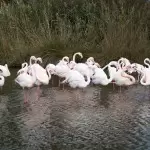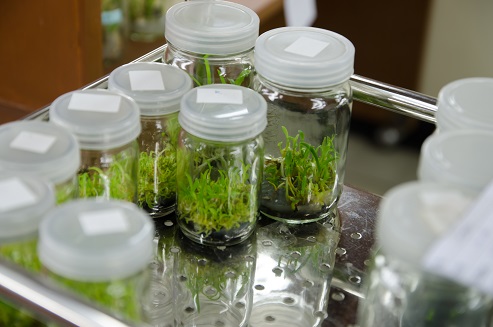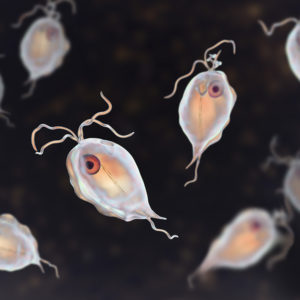
What is Parasitology?
One of the biggest threats to human health today in the developed and the developing world are parasites. Parasitical relationships differ from other areas of ecology in that they not only depend on another species to survive but in the process of doing so, they cause harm to the host. Where there is mutual benefit, this is called symbiosis which is divided into mutualism (where both species benefit - the relationship between pollinating insects and flowers) and commensalism (where one benefits but the other is not harmed such as barnacles). Entamoeba coli, for example, lives in the human gut usually without problems (1) but can be an indicator of other issues such as the dangerous Escherichia coli (E. coli).
Parasitology is the study of species that depend on others for survival that cause harm to the species on which it depends. They can be plant or animal. The former is a type of plant that depends on another plant for its life cycle. Those in the animal kingdom are broadly broken down into three groups:
- Protozoa, the animal-like single-cell organisms that can be ingested or transmitted by insect bites. Malaria is an example of this. Mosquitoes carry the protozoa which then infects the host when the mosquito feeds, making its way into the bloodstream (2)
- Parasitic worms called helminths such as the tapeworm which lives inside the human gut, typically ingested from eating undercooked meat from an infected animal (3). Some parasitic worms in tropical countries can burrow into the skin of the foot
- Arthropods such as insects and arachnids that carry disease or through their biological functions, cause them. The most common example in the west today are ticks and flea - human and animal (4). This group also includes the sexually-transmitted pubic lice
Learn more about parasitologist careers.
Parasitic plants have roots that have evolved to penetrate the roots or stems of another plant and leech from its nutrients. Example of parasitic plants includes mistletoe, the Australian Christmas Tree, and Yellow Rattle.
As most parasites are considerably smaller than the species on which they depend, parasitology is a subdiscipline of microbiology which is, in turn, is a subdiscipline of biology. Today, it is a multidisciplinary approach with aspects of epidemiology, genetics and genomics ecology, botany and zoology. Globally, human infection from parasites number in the billions and can be from the near-harmless (taking only nutrients and energy) to killers responsible for the deaths of millions annually. The same applies to plant biodiversity. Some are harmless to plants while others have the ability to destroy an entire season's harvest of agricultural crops. WHO estimates that around 30% of people in the world today are infected with Ascaris lumbricoides, a nematode. Parasitic diseases such as malaria have only increased despite efforts to combat them. Due to the arrival of AIDS, some have seen a resurgence such as cryptosporidiosis (5).
Parasites are Useful and so is their Study
To many people, parasitology is a fact of life about which they would prefer never to consider. But parasites as an area of study for biologists and microbiologists is useful in understanding many other areas of biology. Researchers have extracted masses of practical data and applied solutions to some common problems in the last and are expected to continue to do so in the future. Most importantly, parasites make up approximately 50% of all biological life (6) and it would be an ecological tragedy if most or all disappeared.

Conservation
Parasites, because they are ubiquitous, are an essential part of the ecology. Their continued survival in any environment is a vital part of the conservation of the ecology and, in some cases, to the species on which they depend for their own survival and lifecycle (7). While a parasite's existence is not, by definition, beneficial to the host species, they are beneficial in many ecological ways (8).
- Population control (trophic interaction) - in the same way that the balance between predator and prey aids the survival of both by ensuring that enough prey is killed so that they don't destroy the ecological balance, parasites may be seen as fulfilling a similar role. Of course, not all hosts are killed by their parasites. They are also a useful food source for non-host species such as lizards and insects
- The food web - they are an integral, and perhaps surprising link in many food webs. In one study of a California salt marsh, parasites were found to be present in 78% of food web interactions. This includes herbivorous grazers and carnivorous predators. They were recently discovered to have a much heavier biomass importance than previously expected. The effects of population control can be a balancing agent for species food and water security also
- Biodiversity - parasites have a major impact on biodiversity through direct impact on the competition between species and between individuals within a species. This is partly population control as discussed above, but also through something called “parasite-mediated competition” where a resistant or immune carrier benefits at the expense of a non-resistant competitor. This can be a good thing for species who are out of control, but it can also have horrific consequences when the resistant species is an invader such as the North American Grey Squirrel in the UK which has damaged the native Red Squirrel population (9). This has come about due to a parasite.
- Promotes genetic diversity amongst species - how sexual reproduction may have come about has been subject to much debate. Certainly, asexual reproduction is much more efficient and many species still clone themselves. But the major advantage of sexual reproduction is genetic diversity which aids the health of the broader population. It is believed that this phenomenon became prevalent in species through selection pressure brought about through parasitism (10)
Forensic Indicators in Criminal Prosecution
Because of their prevalence and what we have come to understand of parasite ecology and environment, forensic scientists looking to build a case or the last steps of a crime victim can use such evidence to determine what they might have eaten, where and how they died, the murder weapon, the crime scene and even where their body may have been stored (11) along with microbiology indicators such as bacterial decay. Parasitic worms are the most important group, but any parasite can be of use to forensic research. Increasingly, the use of evidence from parasitology in forensics is building cases of wildlife crime such as the captive breeding of wild species that people are forbidden from capturing and breeding (12, p51). Indeed, the lack of expected parasites in a host is an indication of captivity.
Uses in Clinical Research
Parasites are not necessarily a disease in themselves (13), but they can cause severe illness and even death in the host patient. Malaria, for example, is one of the most common diseases in the world today and one of the most widely studied too. It is prevalent across tropical Africa where the malaria parasite is common in mosquito species. The parasite is carried to humans and other animals through mosquito bites. In order to combat malaria and other such tropical diseases transported from one host to another, and especially one that infects and kills so many people every year, requires research into the biological mechanics of the carrier and the parasite itself.
Clinical research is not just useful for human health either. It has uses in the medical treatment of animals - pets for human health and agriculture for food and water security to maximize environmental and ecological health (14).
Immune System Research
In general terms, parasites reproduce and thrive by manipulating a host's behavior, bodily functions, and even genetics. It may use markers to “fool” an immune system (15), for example, to stop it from attacking the invading host as antibodies are prone to doing. Parasites do this at the expense of the host's body, leeching nutrients and energy and making it act counterproductively to its one survival in some cases. This approach has benefits for research into the immune system for example, and the ability to mimic the actions of a parasite (such as the chemical markers used to fool the host body) can provide a treatment or a vaccine against infection by the parasite in the first place. Also, understanding how the immune system reacts to these foreign biological entities can be great drivers in new discoveries in medicine.
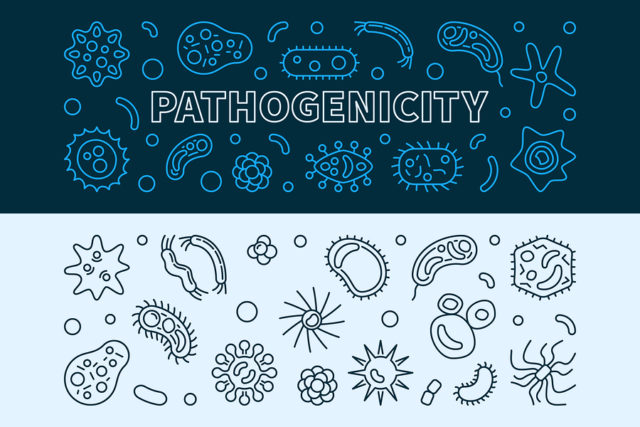
Parasites of Note
It would be impossible to list all species of parasite here as there are so many. However, some are more prevalent, dangerous or famous than others. Each has been the subject of important studies and are demonstrably ecologically important.
Fleas
Perhaps the most famous of all, and the most visible are fleas (16) although they are not the largest parasites. Fleas affect any species of animal with hair, fur, or feathers. This includes humans, cats and dogs and other pets, wild animals such as mice and rats. Livestock is also prone to flea infestation without treatment. Fleas have eight legs and are therefore arachnids, closer genetically to spiders than any insect. With strong hind legs, they can leap relatively huge distances to spread from host to host. They bite and feed on the blood of an infected host and lay eggs in fur which then hatch to spread elsewhere. Dog and cat fleas can bite humans, but they cannot colonize a human body. Human fleas are relatively rare in the developed world today. They are, however, responsible for one of history's deadliest diseases - The Bubonic Plague which was carried by rat fleas infected with bacteria called Yersinia Pestis. Far more common are secondary infection from scratching and itching and the body not healing properly.
Guinea Worm
The Guinea Worm is a parasitical worm that lays larva in water sources. When consumed (usually drinking from substandard water sources) the worm infects the person or animal. The larva then uses the host body to gestate to the adult form. This is not common in western countries and has been common in poorer African countries although it is declining through improved sanitation. This causes a condition called Guinea Worm Disease or GWD and is one of the world's most deadly neglected diseases. It's also the first to be listed as a parasitical disease for eradication - this will mean the elimination of the disease but not the parasite itself. In 2016, the CDC estimated that it is common in just three countries: South Sudan, Ethiopia, and Chad. There were just 25 human cases of the condition in 2016 with only several thousand dog infestations (17).
Horsehair Worm
Although they are included in the nematomorph family, they are not true nematodes. They are longer and thinner and look like strands of straw or clumps of horsehair, especially when found in large masses as they tend to be in the spring. They get their name from a traditional belief that they fell from a horse and somehow came to life, but we know now that this is not true. They are parasites but are of no danger to humans, pets, or livestock. Instead, their lifecycle centers on insects. For grasshoppers, these are deadly. Some parasites simply live off the body of another creature or plant. But there are also parasites that use chemicals and pheromones to make the host lifeform to do something against its natural instincts. In the case of the horsehair worm, that is suicide. An infected insect will (when the parasite is ready to become an adult form) throw itself into a body of water (18) all under the direction of chemical influence.
Mistletoe
One of the two most famous plants associated with Christmas and one under which lovers traditionally kiss is parasitical. There are several dozen varieties of mistletoe and every one of them is parasitical, typically living off trees. Mistletoe does not have roots. Instead of the traditional method of leeching nutrients from the soil, it uses an organ or appendage called the “haustorium” which burrows into trees to hijack nutrients. Unlike many other parasitical plants, mistletoe is flowering and has both male and female varieties. Some also have leaves (the best-known kind certainly does) for photosynthesis so that it can produce its own food. A tree with a mistletoe infestation is not problematic in itself but owners are encouraged to manage the growth effectively or the tree will be unable to sustain itself. While most people are interested in mistletoe for its Christmas association, the plant is intriguing for botany because it is largely a semi-parasite, having qualities of traditional plants too, but lacks several key parts to produce enough energy (19).
Parasitic and Parasitoid Wasps
This is not a single species but a group of some 80,000 species worldwide and probably one of the most diverse groupings of any animal, let alone insect, globally. Most of the 80,000 strong species parasitize just a single species each, usually other insects, which include cockroaches, worms, ants and termites, sometimes spiders. Most are parasitoid rather than parasitic which means they rely on other species for one particular stage of their life. Parasitoid wasps usually use other insects for reproduction but will not feed on them. Like the horseshoe worm mentioned above, these parasitoid wasps use chemicals and pheromones to override the natural instincts of the host, controlling it to engage in activity beneficial to the invading parasite. The Costa Rican parasitoid wasp Hymenoepimecis argyraphaga attaches a larva to the spider's abdomen (20). The chemical signatures then override the spider's web formation. Instead of designing a web to capture its prey, the spider will alter the pattern to create regular, recurring lines. This is virtually useless for catching flies but makes it heavy enough to hold the developing cocoon inside which will be more of the wasps. The Iseropus wasps (of which there are 9 species) is another similar example. They use caterpillars during their cocoon stage to inject their own larva through the wall of the cocoon (21).
“Rafflesia”: The Corpse Flowers
Several plants go by the name “corpse flower” which includes 28 subspecies of Rafflesia. All are found in southeast Asia including Malaysia, Indonesia and Thailand amongst others. Rafflesia has no leaves, roots or even a stem, although it does have a flower (22), and lives solely on native vines. Like mistletoe mentioned above, it has a haustorium which burrows into the flesh of the host plant from which the Rafflesia extracts nutrients that the host plant has absorbed. It does not become visible until it has flowered so a plant could be infected for a long time before any visible signs appear. It's called the “corpse flower” because it has evolved to emit a smell of rotting flesh and some subspecies even look like putrefying flesh. This serves two purposes: the first is a defense mechanism to prevent herbivorous animals from eating it, the second is a pollination tactic to use carrion flies to reproduce. Another plant which is also called a Corpse Flower (the world's largest flower) - the Titan Arum - is not parasitical.
Tapeworm
Living in the intestines of humans, these are quite common globally in the developing and developed world and usually caused by ingesting undercooked meat. They are called tapeworm because they look similar to the DIY tool, the tape measure. They cannot live without a host and sometimes, surgery is required to remove them although in most cases it will require simple oral medication. It is one of the reasons why there are such stringent food hygiene and safety laws. Thankfully, they are not as common in the developed world thanks to food safety. Symptoms of infection include appetite loss, weight loss, fatigue, diarrhea, and abdominal pains (23). Infected people may also see signs of eggs in their stools, or larvae and segments of tapeworm.

Tongue-Eating Louse
Not dangerous to humans, the tongue-eating louse is a fish parasite that swims in through a fish's gills and attaches itself to the tongue. The gender of the parasite can be determined by where it attaches. The female attaches directly to the tongue while the male attaches to the gill's arches. Then it severs the arteries and blood vessels linking the tongue with the rest of the body so that the tongue becomes necrotic and detaches, leaving the parasite to become the fish's new tongue by attaching to the remaining stub. In most cases, it will not damage the fish beyond the removal of the tongue but a fish with more than one parasitical infection can suffer from malnutrition (24). They are widespread across the tropics and subtropics with some isolated cases in temperature regions. The parasite is not harmful to humans but if still alive when the person or animal eats an infected fish, they can bite.
Varroa Mite
Largely believed to play a part in colony collapse disorder in livestock bees, the varroa mite parasitizes certain species of honeybee where it reproduces. It attaches to the body of a drone and sucks the fat from inside, weakening it. It often leaves a colony weakened over the fall and winter when activity is low, not enough food has been stored. Secondary, the varroa mite brings a cocktail of diseases to a honeybee colony, the most damaging of which is the deformed wing virus which - as the description suggests - stunts wings, making it difficult and near impossible for bees to fly to collect pollen. They enter a bee colony and lay in wait until the larval cell is capped over. Then, behind the protection of the wax, they lay eggs on the developing larva. Bees with a parasitical varroa mite are far more prone to infection and disease (25).
Zombie Ant Fungus
Most fungi are not parasitical, feeding off dead organic material. Some go against this such as the zombie ant fungus, or to give it the scientific name Ophiocordyceps unilateralis. It is widespread in tropical rainforests where ants are prevalent and a vital part of the ecosystem. Spores infect an ant while it is foraging in a forest canopy. Here, it breaks through an ant's exoskeleton, throughout the body and to the nervous system and the brain. Then it releases chemicals to infect the brain so that the ant will transport the fungus for the next stage of its life. The ant will walk to the warm, moist forest floor and climb up a stalk where it will clamp to a leaf and wait until it dies - usually of starvation. When the parasite eventually kills the host, it gestates to the germination stage and a stalk forces its way out of the ant's dead body ready for the process to begin again. What is remarkable about this fungi is that can identify the ant species and adapt. An experiment showed that the chemicals released differ depending on the species of the host (26).
A History of Parasitology
Parasites are mostly microscopic and so understanding of their biology, transmission and even their existence has been, for most of human history, largely theoretical. What we know and understand about microparasites are based on what we understand about parasites that we can see with the naked eye such as threadworm, tapeworm, and fleas. Nevertheless, there has been interest in parasitical lifeforms throughout recorded history.
Parasitology in the Ancient World
We know from Egyptian texts that physicians from the highly developed level of public health that they were aware of parasites such as hookworm, guinea worm, threadworm and several others that affected humans and livestock. The Ebers Papyrus is one of the most famous documents known from the period; it recommended taking pomegranate juice to remove tapeworms from the body (27). Around the same time, the Greeks demonstrated a solid understanding of other common human parasites. The Hippocratic Corpus is one of several documents that discuss the bladder worm and recent archaeological surveys have shown that Greeks did indeed suffer from intestinal parasites (28). The Romans are known to have built on the knowledge of the Greeks and Egyptians following their conquest in the early part of the 1st century. Both Galen and Celsus (29) physicians built on the knowledge of several types of roundworm and tapeworm.
While the Western Roman Empire fell, the Eastern Empire (later known as Byzantium) continued to flourish. Paulus Aegineta, a Greek physician from the Eastern Empire described in detail several parasites including tapeworms, the nematode Ascaris, and Enterobius (pinworm) including the symptoms of infection.
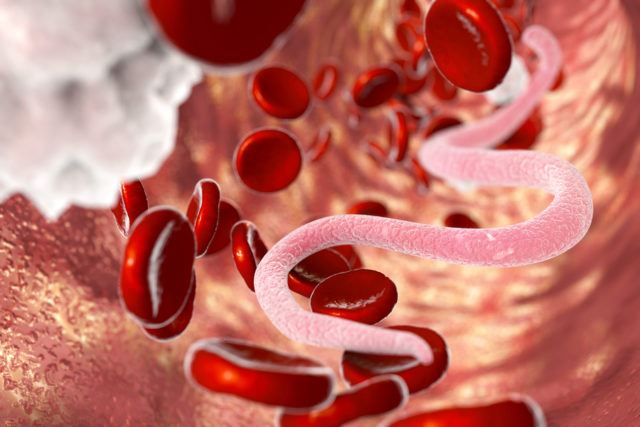
The Medieval World
Learning declined in western Europe for a long time. The work carried on in eastern Europe, but further east, Arab scholars began researching the ancient Greek texts and continuing that vital body of writing. The medieval Arab world produced some remarkable proto-scientific observations, preserving Roman and Greek works and developing its own knowledge. Much of this was philosophical in nature as experimentation had not fully developed yet and neither had many of the scientific tools and methods available to us today. The most notable work is Avicenna, a polymath and one of the greatest thinkers of the Islamic Golden Age (29). He wrote one of the most complete medical volumes of the age and extensively further discussed the parasites listed in much earlier works. The other important Arab physician of not to write about parasites was al-Razi or Rhazes (30). He focused much of his work on guinea worm and theorized that some illnesses were symptoms of parasitical infection.
But what of medieval Europe? Much of the works of scholars from previous eras were largely ignored except for a select few such as Galen. Even then, works were chosen for their use and ignored if they challenged Christian teaching. The only work of note in medieval Europe on parasitology was in 1397 in a book on sheep where Jehan de Brie wrote Traité de l'état, science et pratique de l'art de la Bergerie (translated as: Account of the State, Science and Practice of the Art of Shepherding). In this general guide, he described the livestock parasite sheep liver fluke or common liver fluke Fasciola hepatica. This was after the Black Death and the wool trade was thriving. Infestation could easily damage a herder's livestock and his livelihood. Naturally, the parasite was a common problem and could be transmitted from sheep to humans and working animals (31).
Renaissance and Early Science Era
There is much that modern scientists can thank Antonie van Leeuwenhoek for - the most important of which was the discovery of the microscope and essentially paving the way for the invention of the science of microbiology. With his invention, he observed and sketched several well-known parasites including Giardia lamblia with which he was infected (32). These protozoa were the first to have been recorded and the first examined through a microscope. For such tiny parasites, there had not been a method of recording them previously. The microscope then permitted others to examine other parasites with greater scrutiny. Some that could be seen with the naked eye could now be examined in some detail while others that were not visible could be identified and catalogued.
Two Italian biologists of note from this era - Cosimo Bonomo and Diacinto Cestoni (33) - worked on scabies, identifying the disease as being caused by mites. This was the first disease to be identified as having a causative agent on a microscopic level. Also published in the same volume as their important work, Francesco Redi (34) defined ecto (internal) and endo (external) parasites. He described ticks, nasal flies that infected deer, and expanded on the earlier work of sheep liver fluke. Redi may be considered the father of parasitology as his book “Observations on Living Animals found in Living Animals” is the first dedicated volume. In it are over 100 sketches of parasites; his research finally laid to rest the belief of spontaneous generation of parasites - he proved that many were born from eggs that people and animals had ingested.
Modern Parasitology
All these discoveries and the tools of the new science of biology would inevitably lead to the development of parasitology as a discipline in itself; the term “parasitology” entered the English lexicon in 1870 after decades of important work had already been completed. With so many implications for public health, animal livestock and pet health, it took off quickly in the 19th century, becoming a matter of biological curiosity because of parasite's unique method of reproduction and survival. Its early adherents include James Annersley (35) who identified that the condition “amoebiasis” - an infection of the liver and intestines - was caused by a parasite. Humanity had known and written about this disease from as early as AD200. However, the causative agent - a protozoa called Entamoeba histolytica would not be discovered for another 50 years. That was the honor of Friedrich Lösch.
Another early researcher was James Paget. He discovered Trichinella spiralis, an intestinal nematode, in 1835. Paget is arguably Victorian England's greatest ever physician. A hospital and a disease (Paget's Disease of the Bones) are named in his honor (36) and stressed the importance 100 years before the post-war medical science boom, of utilizing the best tools and rigorous testing in medicine. Some have played down his importance to parasitology (30), stating that he was unaware that the worms he discovered were merely a larval stage of a fully-grown nematode species.
Late in the 19th century, James McConnell discovered the human liver fluke and a year later Louis Alexis Normand in a study of French soldiers returning from the Far East discovered that strongyloidiasis was caused by a parasite. However, at the time he did not know what the larvae were. It was later discovered that the strongyloidiasis parasite is the only one that will reproduce indeifinitely when infecting a human (30). The first discovery that mosquitoes were carrying parasites on not simply transmitting diseases came in the 1870s. In this decade, Patrick Manson identified a nematode worm carried by mosquitoes caused elephantiasis, and later discovered that malaria was also parasitical.
Sub-Disciplines of Parasitology
As parasites are so prevalent, it was inevitable that it would break down into subdisciplines to examine different aspects of parasites and their life cycles.
Immuno-parasitology
Immunoparasitology is the study of the immunology and the interactions of the immune system between a host and an invading parasite (37). It's largely used in the development of vaccines. Researchers look at how the parasite gets around the immune system by use of genetics, specific proteins or chemical reactions of parasites. It's been particularly successful in the last decade with many vaccines successfully developed in veterinary sciences and human health. However, investment is required for continued development in some areas. As discussed above, it is estimated that parasites represent some 50% of all biological life. Not all of these affect humans, our pets, or livestock, but improvements are expected in these areas. There is still much that researchers do not understand and there remains a challenge in examining genetic aspects of the relationship.
Medical Parasitology
This is the branch of parasitology concerned with parasites that affect humans and the medical issues that they cause (38). Some parasites do not cause disease; they simply leech nutrients from the infected person which cause malnutrition and weight loss. However, some carry virulent and deadly diseases. For example, the ectoparasite called “tick” can carry Lyme Disease - the most prevalent parasite-spread disease in the northern hemisphere. Mosquitoes are not parasites, but they can spread parasitical diseases such as malaria. Medical parasitology is also concerned with the development of medical treatments to hinder or neutralize the disease as well as the study of disease genetics, disease diagnosis, prevention, control, and treatment.
Paleoparasitology
This is the intersection between paleontology and parasitology. Simply, it's the study of parasites in the past, their relationships with host species, and disease vectors, epidemiology, pathology and health, paleoecology and paleoclimatology. As paleontology applies to animal species in the past, paleoparasitology is concerned with parasites of extinct animals or extinct parasites and their interactions.
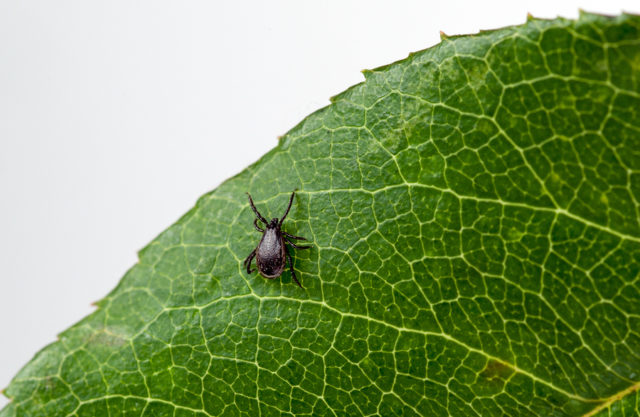
Archaeoparasitology
There is some debate about whether this is a true subdiscipline of parasitology or whether it should be considered in with paleoparasitology. The “archaeo” gives it an archaeological context, meaning that this area of study concerns the interactions between humans of the past and human ancestor species, and their relationships and ecology with parasites.
Parasitic Conservation Biology
It may seem inconceivable to be concerned about the conservation status and continued existence of parasites, but they have a vital role to play in local and planetary ecology. However, they represent an enormous area of biology and their existence is vital to ecological balance on local and global systems. Those that are responsible for diseases have uses in population control to ensure species do not become imbalanced, leading to ecological damage (39). Due to the diseases they can cause, some governments have opted for a systemic program of eradication of the parasite itself instead of releasing funding for treatment, prevention, and cure of the conditions for which they are sometimes responsible in people, livestock, and food crops. Conservation biologists attempt to challenge the view of parasites of being (at best) useless and (at worst) a menace that would lead to better health and ecology without them. Conservationists are presently pushing for funding and awareness for greater research and appreciation of this broad area of biological research.
Parasitic Molecular Biology
Molecular biology is a cross disciplinary area of chemistry and biology, with a particular focus on biochemistry, genetics, and biology at a micro level. It examines the interactions between a cell's systems such as RNA and DNA, and the processes of synthesizing proteins with a particular focus on how these interactions take place and their regulation. Everything that applies to regular molecular biology applies here but to parasites and their interactions in their own bodies and in the host-parasite relationship. Many of these interactions have protein and DNA markers, particularly in how the parasite fools the genetic code of the host and the potential problems for the immune system. This is sometimes also known as molecular parasitology (40).
Parasite Ecology
Ecology is the relationship between living things in an ecosystem. We sometimes perceive it as conservationism; that plays a small part of the ecology, but only one part in a wide web of areas of research. Essentially, ecology is the study of the network of life. In parasite ecology, researchers examine the range of attributes that parasites bring to a biome and the consequences (positive and negative) or their existence. Like all other biological life, parasites have adapted and continue to adapt to changes to their environment including environmental change, immune resistance and other defensive strategies of hosts, their abilities to jump species (where possible) and the relationship between carriers who are not affected by the parasite and the hosts who are affected. Their complex lifecycle within an environment is also of interest, as is the effects they have on each species within a biome (41). Finally, researchers examine abundance, prevalence, and the conditions that would lead to change.
Structural Parasitology
To understand parasites, it's necessary to understand many aspects of their anatomy. Parasite molecular biology is one of those areas. Another is structural parasitology which is the study of parasite proteins through the application of technology such as NMR and x-ray crystallography. The aim is to understand 3D modeling of proteins and the molecules in a parasitical relationship - applying to the parasite, its host, and their interactions. One of the major aims here is to examine functional pathways in organisms, comparing them to their hosts. Ultimately, it is hoped that discovering and understanding these links will lead to better vaccines for prevention, treatment of disease, and removal of the symptoms and diseases that they sometimes cause (42). In particular, it is hoped that the control and treatment of malaria will most benefit from this research area.
Quantitative Parasitology
Quantitative parasite ecology, the term “qualitative” refers to the use of applied mathematics and data modelling, usually involving statistics and distribution, in the examination of something. That is no different for parasitology. Each parasite species will tend to have an aggregated distribution among hosts. What this means is that most potential hosts carry few or no parasites while a relatively small number carry a large number of individual parasites (43). The bell curve is heavily weighted at the lower end. This goes against the typical balance of ecology and biology in general which is usually slightly skewed to the right (at the higher end). Quantitative parasitology, therefore, utilizes advanced biostatistical methods and applications to understand such distributions.
Parasite Taxonomy and Phylogenetics
Taxonomy: The science of classifying biological species
Phylogeny: the examination of a species evolutionary history and lineage
In simple terms, parasite taxonomy and phylogenetics are areas of study that concern the evolution of parasites in terms of their relationships to other species (44), common ancestry and their classification in the phylogenetic tree. This is a complex area prone to complications and confusion as few species (and this applies to botany and zoology broadly, not just parasitology) fit neatly in a single box. Relationships between species are complex because of shared genetic traits and independent traits evolving in separate species. Where parasitology is concerned, it is not just concerned with evolution and relationships between related species, but also in the evolution of species to their hosts - why they affect some and not others.
Veterinary Parasitology
Veterinary sciences concern the interactions between animals and humans that are an every-day part of human life. This includes pets and livestock, for example. Many of these species have the potential to be infected with a parasite and experience disease and disease symptoms when infected. Veterinary parasitology is the study of parasites in animals - mostly species used in a domestic context, but also in some areas of wildlife. As well as the interactions, researchers study the genesis and the development in animal hosts, of their parasites, and the taxonomy (see above), morphology, systematics, and life cycle. This is largely an area of medical science overlapping with treatment and vaccine research to ensure minimal impact of sickness on human health and economics and livelihood. Its primary function is to improve and protect health (45).
Current Parasitology Challenges and Developments - Issues of Concern in Parasitology
Climate Change Spreading Disease
It's been widely reported that a changing climate is leading to increased instances of some parasite-related diseases and some spreading out of their traditional tropical and subtropical zones. Diseases are already spreading (46) thanks to the warming climate. Malaria cannot survive at temperatures below 20C and as climate change continues to increase warming some researchers expect malaria to spread to North Africa and eventually into southern Europe (47), similarly with dengue in the Pacific and Caribbean. Some expect it to reach the southern US states if temperatures continue to rise at the rate that they are presently rising. Evidence for this is limited at present, but temperature rises have yet to reach the required averages in the subtropical areas of the Americas, Africa, and southern Europe.
Climate Change Impact on Vulnerable Species
There are hundreds of species on the vulnerable and at-risk register. As parasites depend on these species, their continued existence - and the balance to the ecology that they provide - depend heavily on the existence of their hosts (48). Despite that many parasites such as those that cause dengue and malaria can expect to benefit from a changing climate, there are many more that are presently at risk and that is not good for their survival. Parasites are likely to become extinct before their host species. With limited numbers of hosts come limited chances for infection and therefore, parasite reproduction. One example of this is the marsupial woylie, also known as the brush-tailed bettong. Just one hundred years ago, it was endemic to Western Australia but with only 5,600 of their numbers, is on the brink of extinction. The situation for its most common parasite is even direr (49).
Prejudice Towards Parasitism
While researchers understand the importance of parasites to ecology and the food chain (46), that understanding has not transmitted well outside of the biological research arena. The very word “parasite” has a negative connotation; it is used against people and targeted groups. This continues the prejudice against these remarkable and unique plants and animals, fueling a belief that they not only don't serve a purpose - but also that they provide no benefit, taking and not giving. This has led to low funding and low interest in parasite research outside of the academic community for academia's sake. There is funding for medical research, but not simply to understand lifecycle and genetics. This has led to conservation issues of some critically endangered or vulnerable species.
Emerging Parasites
Because of parasite prevalence, diseases that they can cause is a global health concern. It is complex and resource-intensive to cope with the diseases that we know about. Climate change, resistance to treatment, remission or disappearance of other conditions and a number of other factors is leading to emerging or re-emerging diseases (49). trypanosomiasis, schistosomiasis, and leishmaniasis have all been in remission for generations but trypanosomiasis (resulting from the infection of a protozoan that spreads sleeping sickness to humans) is now in epidemic proportions in Africa in the last few years. Leishmaniasis, a New World disease spread by a protozoan called Leishmania spread by sand flies) is reaching out into new areas that had not previously experienced them. Malaria is no emerging but it is spreading and now kills more people than all other diseases except tuberculosis.
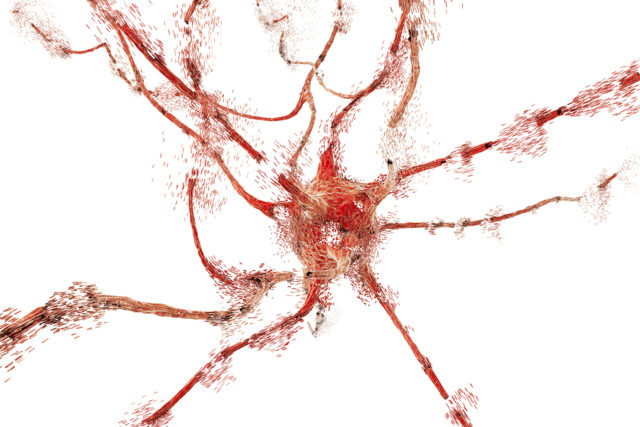
Future Developments for Parasitology
“One Health” Approach
Traditionally, health research and treatment has existed within each of its individual bubbles unless there was a clear and defined relationship. However, that is not and has never been the reality of any biological research. As ecology becomes more integral and the importance of relationships between biological systems becomes clearer, more overlaps and cross-disciplinary approaches are required and created. Today, there is a move towards what is called a “one health” approach (46). Essentially, this is treating health as a global network. The pursuit of human and veterinary health should not lead to poor ecological health. This is one area where parasitology has been at loggerheads with health. Today, with a greater understanding of the importance of parasites to the environment, there is a change of attitude towards co-existence and eradication of disease, but not of the species.
Parasites as Vital For Sustainability
Parasites are perhaps not the first thing that come to mind when considering sustainability of ecology, ecosystems, and conservation issues. As discussed in the previous section, we know they are now vital for ecological health, species health (population control as a vector for ensuring populations do not grow out of control) by picking off the weakest in a population, much as predators do. There has been a fundamental shift in the last couple of decades to begin to see parasites through a similar lens with which we view predators. That means, researchers perceive them as vital for sustainability.
Use of GIS in Parasite Management
Geographical Information Systems has been a boon to many areas of research. Utilizing qualitative big data analytics which it then outputs into a map form for digestible analysis by a variety of stakeholders, GIS has also made some great strides in and for parasitology. It provides functionality that conventional cartography could rarely achieve. In the last decade alone, major studies using GIS have been successfully conducted on ticks as vectors for Lyme Disease and Encephalitis, Malarial and Rift Valley Disease-carrying mosquitoes, midges, and insects that carry liver fluke (51). As certain diseases re-emerge or spread due to climate change, it is expected to become a fundamental tool in the planning of relief services and management of such conditions. This has also included remote sensing, and spatial data analysis, just as it has continued to be for general health issues, disaster management, and public health.
Sources
- http://www.uobabylon.edu.iq/uobColeges/ad_downloads/6_8923_469.pdf
- http://www.who.int/ith/diseases/malaria/en/
- https://www.webmd.com/digestive-disorders/tapeworms-in-humans#1
- https://parasite.org.au/para-site/contents/arthropod-intoduction.html
- https://clinicalinfo.hiv.gov/en/guidelines/adult-and-adolescent-opportunistic-infection/whats-new-guidelines
- https://parasite.org.au/para-site/introduction/introduction.html
- https://www.sciencedirect.com/science/article/pii/S2213224413000230
- https://www.nature.com/scitable/knowledge/library/ecological-consequences-of-parasitism-13255694
- http://citeseerx.ist.psu.edu/viewdoc/download?doi=10.1.1.63.4689&rep=rep1&type=pdf
- https://www.livescience.com/14946-parasite-infection-sex.html
- https://www.ncbi.nlm.nih.gov/pubmed/29385324
- http://www.tracenetwork.org/wp-content/uploads/2012/08/2-wildlife-crime-forensics-guide.pdf
- https://www.sciencedirect.com/topics/medicine-and-dentistry/parasitology
- journalofparasitology.org/page/news/Can_Parasitology_Ride_the_Rising_Star_of_Disease_Ecology?code=asp-site
- https://www.nature.com/articles/s41598-018-23194-9
- https://skinparasites.ucdavis.edu/fleas
- https://www.cdc.gov/parasites/guineaworm/gen_info/faqs.html
- https://www.newscientist.com/article/dn7927-parasites-brainwash-grasshoppers-into-death-dive/
- http://www.sciencemag.org/news/2018/05/mistletoe-missing-machinery-make-energy
- http://animaldiversity.org/accounts/Hymenoepimecis_argyraphaga/
- http://www.nhm.ac.uk/discover/body-snatchers-eaten-alive.html
- http://powo.science.kew.org/taxon/urn:lsid:ipni.org:names:316069-1
- https://www.medicalnewstoday.com/articles/170461.php
- http://www.desertmuseum.org/center/seaofcortez/docs/brusca_1981_cymothoidae.pdf
- https://www.livescience.com/47751-zombie-fungus-picky-about-ant-brains.html
- http://www.tropicalparasitology.org/article.asp?issn=2229-5070;year=2013;volume=3;issue=2;spage=170;epage=174;aulast=
- https://www.cam.ac.uk/research/news/ancient-faeces-reveal-parasites-described-in-earliest-greek-medical-texts
- https://www.ncbi.nlm.nih.gov/pmc/articles/PMC126866/
- https://cmr.asm.org/content/15/4/595.full
- http://expositions.bnf.fr/bestiaire/arret/5/1.htm
- https://web.stanford.edu/class/humbio103/ParaSites2006/Giardiasis/history.htm
- https://www.scribd.com/document/266944167/Giovan-Cosimo-Bonomo-1663-1696-Discoverer-of-the-Etiology-of-Scabies
- https://www.ncbi.nlm.nih.gov/pubmed/24509515
- http://www.apiindia.org/medicine_update_2013/chap01.pdf
- https://www.jpaget.nhs.uk/about-us/who-was-sir-james-paget/
- https://www.ncbi.nlm.nih.gov/pubmed/3044255
- https://www.omicsonline.org/scholarly/medical-parasitology-journals-articles-ppts-list.php
- https://conbio.onlinelibrary.wiley.com/doi/abs/10.1111/cobi.12634
- https://www.sciencedirect.com/book/9780124733459/biochemistry-and-molecular-biology-of-parasites
- https://serc.si.edu/research/research-topics/parasite-disease-ecology/parasite-ecology-biogeography
- https://www.thesgc.org/science/parasitology
- http://www.zoologia.hu/qp/BRIEFGUIDE3.pdf
- https://www.ncbi.nlm.nih.gov/pmc/articles/PMC2733197/
- https://www.omicsonline.org/veterinary-parasitology-articles.php
- https://www.frontiersin.org/articles/10.3389/fvets.2014.00025/full
- https://scied.ucar.edu/longcontent/climate-change-and-vector-borne-disease
- https://royalsocietypublishing.org/doi/full/10.1098/rsos.160535
- https://www.sciencedirect.com/science/article/pii/S0020751905000718
- https://pdfs.semanticscholar.org/f390/3866eb1e71bce9c6b6a402d285020d047240.pdf
- Guide to Parasitology - November 19, 2018
- Deserts as Ecosystems and Why They Need Protecting - November 19, 2018
- Conservation: History and Future - September 14, 2018


